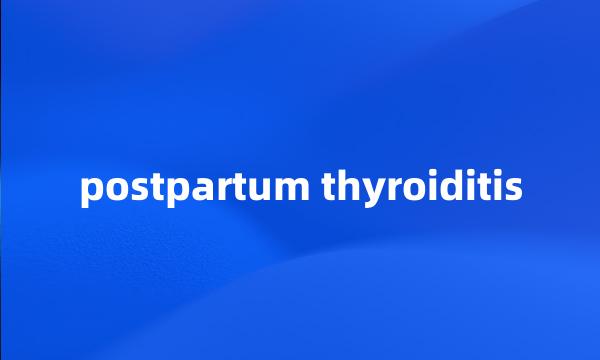postpartum thyroiditis
- 网络产后甲状腺炎
 postpartum thyroiditis
postpartum thyroiditis-
Dynamic change of serum TGF - β _1 level in patients with postpartum thyroiditis
产后甲状腺炎患者血清转化生长因子β1的动态变化
-
Postpartum thyroiditis : a prospective epidemiological survey in Chinese women
产后甲状腺炎的前瞻性临床流行病学调查
-
An Epidemiological and Basic Study on Postpartum Thyroiditis
产后甲状腺炎的流行病学和实验研究
-
Main Outcome Measures : We measured incidence , clinical presentation , and course of postpartum thyroiditis .
主要观察指标:我们观察了产后甲状腺炎的发病率、临床表现和发病过程。
-
Postpartum Thyroiditis : Epidemiologic Data Enlightens Health Education
产后甲状腺炎流行病学资料对健康教育的启示
-
Effects of iodine intake on pathogenesis of postpartum thyroiditis
碘摄入量对产后甲状腺炎发生、发展的影响
-
Misdiagnosis of painless postpartum thyroiditis : analysis of fourty cases
产后无痛性甲状腺炎23例误诊分析
-
In total , 169 ( 3.9 % ) of the women had postpartum thyroiditis .
总共169例妇女(3.9%)患有产后甲状腺炎。
-
Context : The incidence of postpartum thyroiditis ( PPT ) varies widely in the literature .
背景:文献中产后甲状腺炎的发生率(PPT)差异很大。
-
The risk of postpartum thyroiditis was significantly elevated in the high-risk group ( odds ratio , 6.69 ) .
高危人群组产后甲状腺炎的风险显著升高(风险比:6.69)。
-
Preface [ Conception ] Postpartum thyroiditis ( PPT ) is a common type of autoimmune thyroid diseases ( AITD ) .
概念:产后甲状腺炎(Postpartumthyroiditis,PPT)是自身免疫甲状腺病的一个常见类型。
-
In a Chinese female population , the positive rate of thyroid autoantibodies was 11.0 % , and the prevalence of postpartum thyroiditis was 11.9 % .
流行病学调查显示普通女性人群的甲状腺自身抗体的阳性率是11.0%;产后甲状腺炎的患病率是11.9%。
-
Objective To study the genetic susceptibility in patients with postpartum thyroiditis ( PPT ) by genotyping their human leukocyte antigen ( HLA ) - DP and - DQ alleles .
目的探讨产后甲状腺炎(PPT)与人类白细胞抗原(HLA)-DP、HLA-DQ位点等位基因的相关性及产后甲状腺炎的遗传易患性。
